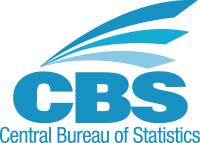General facts of Curaçao
| Flag | |
| Capital | Willemstad |
| Location | Southern Caribbean sea, 65 km (40mi) north of the Venezuelan coast |
| Time zone | UTC -4: AST: Atlantic Standard Time |
| Currency | Antillean Guilder (ANG) |
| Official languages | Papiamentu, Dutch, English |
| Area | 444 km2 / 171.4 sq.mi |
| Highest point | 372 m (Mount St. Christopher) |
Total population (1 January 2025) | 156.115 |
| male | 70.310 (45%) |
| female | 85.805 (55%) |
| Population density | 335.2 /km² (January 1st, 2025) |
| History: | |
| 1499 | Discovered by Alonso de Ojeda. Spaniards settle on Curaçao |
| 1634 | The Dutch conquer Curaçao from Spain |
| 1795 | A slave revolt took place in the Dutch colony of Curaçao in 1795, led by Tula, a local slave, and resulted in a month-long conflict on the island between escapees and the colonial government. |
1800-1803 | First British occupation |
| 1807-1816 | Second British occupation |
| 1863 | Slavery abolished |
| 1954 | The Netherlands Antilles (Curaçao, Aruba, Bonaire, St.Maarten, St.Eustatius end Saba) are granted internal autonomy within the Kingdom of the Netherlands |
| 2010 | The Netherlands Antilles (Curaçao, Bonaire, St.Maarten, St.Eustatius and Saba) became autonomous states within the Kingdom of the Netherlands, a similar status as that of Aruba, whereas the smaller islands Bonaire, Saba and St.Eustatius became special Dutch municipalities |
| Government | Unitary parliamentary representative democracy under constitutional monarchy. |
